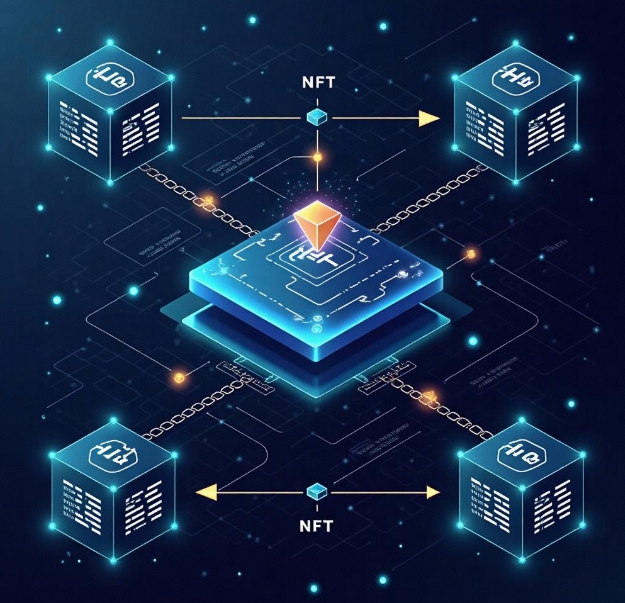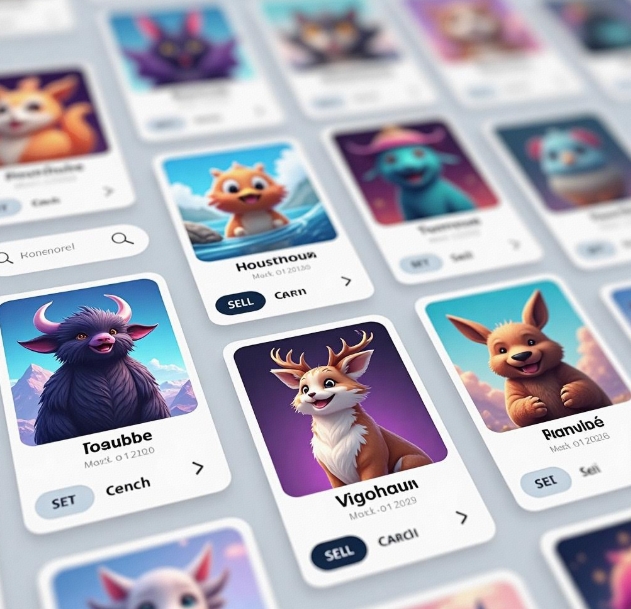Complete Guide to NFT DApp Development: How to Create an NFT Marketplace on the Blockchain?
- latest articles
- 1.DApp Development & Customization: Merging Diverse Market Needs with User Experience 2.Analysis of the Core Technical System in DApp Project Development 3.How to achieve cross-chain interoperability in Web3 projects? 4.How does the tokenization of points reconstruct the e-commerce ecosystem? 5.How to Set and Track Data Metrics for a Points Mall? 6.What is DApp Development? Core Concepts and Technical Analysis 7.Inventory of commonly used Web3 development tools and usage tips 8.Development of a Distribution System Integrated with Social E-commerce 9.Six Key Steps for Businesses to Build a Points Mall System 10.What is DApp Development? A Comprehensive Guide from Concept to Implementation
- Popular Articles
- 1.Future Trends and Technology Predictions for APP Development in 2025 2.Analysis of the DeFi Ecosystem: How Developers Can Participate in Decentralized Finance Innovation 3.From Zero to One: How PI Mall Revolutionizes the Traditional E-commerce Model 4.DAPP Development | Best Practices for Professional Customization and Rapid Launch 5.Recommended by the Web3 developer community: the most noteworthy forums and resources 6.From Cloud Computing to Computing Power Leasing: Building a Flexible and Scalable Computing Resource Platform 7.How to Develop a Successful Douyin Mini Program: Technical Architecture and Best Practices 8.Shared Bike System APP: The Convenient Choice in the Era of Smart Travel 9.How to Create a Successful Dating App: From Needs Analysis to User Experience Design 10.From Design to Development: The Complete Process of Bringing an APP Idea to Life
With the continuous development and innovation of blockchain technology, NFTs (Non-Fungible Tokens) have become one of the hottest technologies in recent years in industries such as digital art, gaming, and music. NFTs not only disrupt traditional methods of collecting and trading but also endow digital assets with unique value and identity. The emergence of NFTs has revealed a new world of the digital economy, providing artists, collectors, and investors with a novel platform through smart contracts and decentralized features.
In this digital age, more and more developers and businesses hope to achieve their commercial goals by developing NFT DApps (Decentralized Applications). So, how can one create a successful NFT marketplace on the blockchain? This article will provide a detailed analysis of the NFT DApp development process, including the technical framework, core functionalities, development steps, as well as common challenges and solutions.
I. Overview of NFT DApps
An NFT DApp is a decentralized application built on a blockchain platform that allows users to create, buy, sell, and trade NFTs. Unlike traditional tokens (such as Bitcoin, Ethereum, etc.), NFTs are non-fungible; each NFT has a unique identifier and metadata, representing a specific digital asset.
A successful NFT marketplace typically includes the following main components:
NFT Minting: Users can create their own NFTs and put them on the blockchain, ensuring their uniqueness and tradability.
NFT Trading: Users can buy and sell NFTs through the marketplace.
Smart Contracts: Actions such as minting, trading, and transferring NFTs are automatically executed through smart contracts.
User Interface: Provides a user-friendly interface that enables users to operate conveniently.
II. Choosing the Right Blockchain Platform
When developing an NFT DApp, choosing the right blockchain platform is crucial. Different blockchain platforms offer different features, performance, and security, so developers need to select a platform based on specific requirements.
1. Ethereum
Ethereum is the earliest blockchain platform to support NFTs and is currently the most popular NFT platform. Ethereum's smart contract functionality makes the creation and trading of NFTs possible. Ethereum's ERC-721 and ERC-1155 standards are the most widely adopted NFT standards today.
Advantages:
Strong developer community and documentation support.
Supports NFT standards like ERC-721 and ERC-1155.
High network security.
Disadvantages:
Network congestion leads to high transaction fees.
Slow transaction speeds, making it difficult to meet large-scale application demands.
2. Binance Smart Chain (BSC)
Binance Smart Chain is a blockchain platform launched by Binance, designed to offer lower transaction fees and faster transaction confirmation times. BSC supports NFT standards such as BEP-721 and BEP-1155.
Advantages:
Low transaction fees and fast speeds.
Fully compatible with the Ethereum ecosystem, easy to develop on.
Disadvantages:
Lower degree of decentralization compared to Ethereum.
Relatively weaker community and developer support.
3. Solana
Solana is a high-performance blockchain platform that, with its high throughput and low latency, has become an ideal choice for developing NFT marketplaces. Solana's transaction fees are also very low, making it suitable for large-scale NFT trading platforms.
Advantages:
Extremely fast transaction speeds, processing thousands of transactions per second.
Low transaction fees, suitable for large-scale applications.
Disadvantages:
Compared to Ethereum, the ecosystem is younger, with fewer tools and resources available.
4. Polygon
Polygon is a Layer 2 scaling solution built on Ethereum, improving transaction throughput and reducing fees through sidechain technology. Polygon has become a popular NFT platform.
Advantages:
High throughput, low transaction fees.
Fully compatible with Ethereum's NFT ecosystem.
Disadvantages:
Due to reliance on Ethereum, there are still some issues with the degree of decentralization.
III. Core Functional Modules of NFT DApps
When developing an NFT marketplace, the following core functional modules are typically required:
1. NFT Minting
NFT minting is one of the key functions in an NFT DApp. Users can create their own NFTs through the DApp and store them on the blockchain. This process usually requires calling smart contracts.
The minting process typically includes the following steps:
Upload digital assets (such as images, videos, audio, etc.).
Fill in the NFT's metadata (such as name, description, tags, etc.).
Set the NFT's unique identifier and attributes.
Complete the NFT minting and put it on the blockchain.
2. Marketplace Trading
The NFT marketplace is the most important component of an NFT DApp. Marketplace functions typically include:
Browsing NFTs: Users can browse NFTs by category and view detailed information.
Buying and Selling: Users can list their NFTs for sale or purchase NFTs from other users.
Auction Functionality: Some platforms also offer auction features, allowing users to trade through bidding.
Transaction History: Users can view the transaction history of each NFT, including sale prices, buyers, sellers, and other information.
3. Wallet Integration
Wallet integration is an essential function for any blockchain application. NFT DApps typically need to integrate with digital wallets, allowing users to store and manage their NFT assets. Common blockchain wallets include MetaMask, Trust Wallet, Coinbase Wallet, etc.
4. Smart Contracts
Smart contracts are the core of NFT DApps, ensuring the automatic execution and security of operations such as NFT creation, trading, and transfer. Smart contracts typically include:
Minting Contracts: Used to create NFTs and store them on the blockchain.
Trading Contracts: Used to execute the buying and selling of NFTs.
Royalty Contracts: Used to ensure NFT creators receive a certain percentage of royalties from each transaction.
5. Search and Filtering Functions
To enhance the user experience, NFT marketplaces typically need to provide powerful search and filtering functions to help users quickly find NFTs of interest. These functions include:
Filtering by category, price, collector, creator, etc.
Sorting by time, popularity, trading volume, etc.
IV. Development Steps for NFT DApps
Developing a complete NFT DApp involves multiple steps, including frontend, backend, blockchain, and smart contract development. The following is a general development process:
1. Requirements Analysis and Design
Before development, it is necessary to conduct requirements analysis to clarify the functional needs and target users of the NFT marketplace. Based on the requirements, design the system architecture and determine the technology stack and blockchain platform to be used.
2. Smart Contract Development
Based on the NFT marketplace requirements, write the smart contracts. Typically, NFT smart contracts need to follow standards such as ERC-721 or ERC-1155 to ensure the uniqueness and tradability of NFTs. Special attention must be paid to security during smart contract development to prevent vulnerabilities and attacks.
3. Frontend Development
The frontend is the interface through which users interact with the NFT marketplace, typically developed using modern frontend frameworks like React or Vue.js. The frontend needs to interact with smart contracts to complete functions such as NFT creation, purchase, and sale.
4. Backend Development
The backend is used for data storage and management. Technologies like Node.js or Python can be used to build backend services. The backend needs to interact with the blockchain to ensure data security and consistency.
5. Wallet Integration
Integrating digital wallets allows users to securely store and manage NFTs. The frontend needs to interact with wallet APIs to ensure users can smoothly complete NFT minting, purchasing, and selling operations.
6. Testing and Deployment
After development is complete, conduct comprehensive testing to ensure system stability and security. The testing phase includes functional testing, security testing, performance testing, etc. Finally, deploy the DApp to the production environment and release it for user use.
V. Common Challenges and Solutions
During the development of NFT DApps, developers may encounter some challenges. The following are common challenges and their solutions:
1. High Transaction Fees
Blockchain transaction fees are a common issue when developing NFT marketplaces. Especially on the Ethereum platform, transaction fees can be very high, affecting the user experience.
Solutions:
Choose blockchain platforms with low transaction fees, such as Binance Smart Chain, Polygon, etc.
Use Layer 2 solutions, such as Optimistic Rollups, zk-Rollups, etc., to reduce transaction fees.
2. Network Congestion
When NFT marketplace transaction volumes surge, the blockchain network may become congested, leading to transaction delays.
Solutions:
Choose high-throughput blockchain platforms, such as Solana, Binance Smart Chain, etc.
Optimize smart contracts to reduce transaction complexity and improve efficiency.
3. Security Issues
Since NFT DApps involve asset transfers and transactions, security issues are crucial. Vulnerabilities in smart contracts, wallet security issues, etc., can lead to the loss of user assets.
Solutions:
Strictly audit smart contracts to ensure they have no security vulnerabilities.
Use security measures such as multi-signature wallets to ensure the safety of user assets.
VI. Conclusion
As a new application scenario, NFT DApps are leading the revolution in digital assets. Through blockchain technology, NFTs break the limitations of traditional markets, providing a new platform for artists, creators, and investors. When developing an NFT marketplace, developers need to comprehensively consider various aspects, including the choice of blockchain platform, smart contract design, frontend and backend development, etc., to ensure system security, performance, and user experience.
With the continuous maturation of blockchain technology, the prospects for NFT marketplaces are very broad. In the future, NFTs will not only occupy a place in the digital art field but may also expand to more industries, such as real estate, intellectual property, entertainment, etc. Developing a successful NFT DApp is undoubtedly an exploration journey full of challenges and opportunities.
-

DApp Development & Customization: Merging Diverse Market Needs with User Experience
As blockchain technology matures and becomes more widespread, decentralized appl···
-

Analysis of the Core Technical System in DApp Project Development
With the rapid development of blockchain technology, decentralized applications ···
-

What is DApp Development? Core Concepts and Technical Analysis
With the rapid development of blockchain technology, decentralized applications ···

 Blockchain
Blockchain












